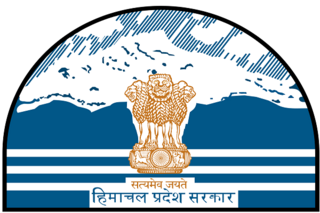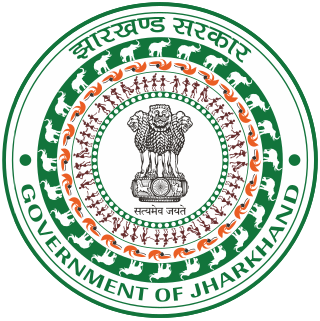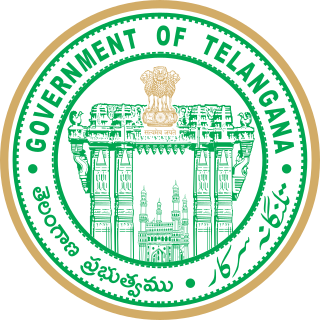The Government of Rajasthan is the supreme governing authority of the Indian state of Rajasthan and its 50 districts. It consists of an executive branch, led by the governor of Rajasthan, as well as judiciary and legislative branches. Jaipur is the capital of Rajasthan, and houses the Vidhan Sabha and the secretariat.

The Government of Himachal Pradesh also known as the State Government of Himachal Pradesh, or locally as State Government, is the supreme governing authority of the Indian state of Himachal Pradesh. It consists of an executive branch, led by the Governor of Himachal Pradesh, a judiciary and a legislative branch.
The Government of Uttar Pradesh is the subnational government of the Indian state of Uttar Pradesh with the governor as its appointed constitutional head of the state by the President of India. The Governor of Uttar Pradesh is appointed for a period of five years and appoints the Chief Minister of Uttar Pradesh and their council of ministers, who are vested with the executive powers of the state. The governor remains a ceremonial head of the state, while the chief minister and their council are responsible for day-to-day government functions.

The Government of Bihar or Bihar Government is the state government of the Indian state of Bihar and its nine divisions which consist of 38 districts. It consists of an executive, led by the Governor of Bihar, a judiciary and legislative branches.

Government of Chhattisgarh also known as the State Government of Chhattisgarh, or locally as State Government, is the supreme governing authority of the Indian state of Chhattisgarh and its 33 districts. It consists of an executive, led by the Governor of Chhattisgarh, a judiciary and a legislative branch.

The Government of Gujarat, also known as GujaratGovernment, is the supreme governing authority of the Indian state of Gujarat and its 33 districts. It consists of an executive of the legislators appointed by the Governor of Gujarat, a judiciary and of a publicly elected legislative body.

Government of Haryana, also known as the State Government of Haryana, or locally as the Haryana Government, is the supreme governing authority of the Indian state of Haryana and its 22 districts. It consists of an executive, ceremonially led by the Governor of Haryana and otherwise by the Chief Minister, a judiciary, and a legislative branch.

The Government of Jharkhand also known as the State Government of Jharkhand, or locally as State Government, is the supreme governing authority of the Indian state of Jharkhand and its 24 districts. It consists of an executive, led by the Governor of Jharkhand, a judiciary and a legislative branch.
The Government of Manipur, also known as the State Government of Manipur, or locally as State Government, is the supreme governing authority of the Indian state of Manipur and its 16 districts. It consists of an executive, led by the Governor of Manipur, a judiciary and a legislative branch.
The Government of Meghalaya, also known as the State Government of Meghalaya, is the supreme governing authority of the Indian state of Meghalaya and its 11 districts. It consists of an executive, led by the Governor of Meghalaya, a judiciary and a legislative branch.
The Government of Nagaland also known as the State Government of Nagaland, or locally as State Government, is the governing authority of the India state of Nagaland and its 16 districts. It consists of an executive, led by the Governor of Nagaland, a judiciary and a legislative branch. Kohima is the capital of Nagaland, and houses the Vidhan Sabha and the secretariat.

The government of the Indian state of Odisha and its 30 districts consists of an executive, led by the Governor of Odisha, a judiciary, and a legislative branch.

The Government of Tripura, also known as the State Government of Tripura, or locally as State Government, is the supreme governing authority of the Indian state of Tripura and its 8 districts. It consists of an executive, led by the Governor of Tripura, a judiciary and a legislative branch.

The Government of Uttarakhand also known as the State Government of Uttarakhand, or locally as State Government, is the subnational government of the Indian state of Uttarakhand and its 13 Districts. It consists of an executive branch, led by the Governor of Uttarakhand, a legislative branch led by the Chief Minister of Uttarakhand and a judiciary branch, led by the Chief Justice of Uttarakhand.
State governments in India are the governments ruling over 28 states and 8 union territories of India and the head of the Council of Ministers in a state is the Chief Minister. Power is divided between the Union government and state governments. While the Union government handles defence, external affairs etc., the state government deals with internal security and other state issues. Income for the Union government is from customs duty, excise tax, income tax etc., while state government income comes from sales tax (VAT), stamp duty etc.; now these have been subsumed under the various components of the Goods and Services Tax

The Himachal Pradesh Legislative Assembly is the unicameral legislature of the Indian state of Himachal Pradesh. The seat of the Assembly is at Shimla, the capital of the state. There are 68 Members of Legislative Assembly, all directly elected from single-seat constituencies. Its term is 5 years, unless sooner dissolved.

Pandit Ram Kishore Shukla was an Indian politician and an activist for Indian independence.

The Government of Telangana also known as TelanganaGovernment, is the governing authority of the state of Telangana in India. It consists of an executive, a judiciary and a legislative.

The Madhya Pradesh Vidhan Sabha or the Madhya Pradesh Legislative Assembly is the unicameral state legislature of Madhya Pradesh state in India.

Located in Lucknow, the Vidhan Bhavan is the seat of the bicameral legislature of the Indian state of Uttar Pradesh. The lower house is the Vidhan Sabha and the upper house is called the Vidhan Parishad or the. The Vidhan Sabha had 431 members until 1967, but now comprises 403 directly elected members and one nominated member from the Anglo-Indian community. The Vidhan Parishad has 100 members.













